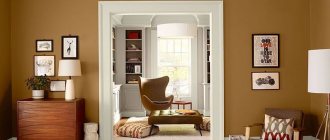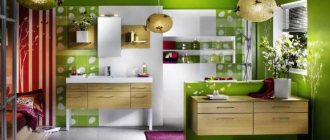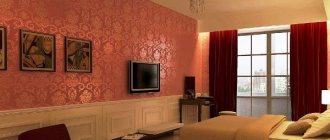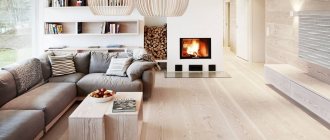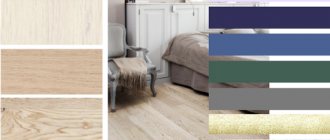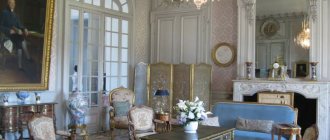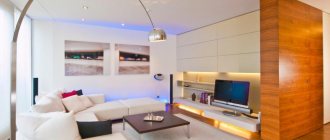Olive shades are an excellent choice for interior decoration. They fill the house with natural notes, making it cozier and warmer. Unlike true green tones, olive colors look more restrained and calm. They can be distributed throughout the house or concentrated in one room. Then you will get a comfortable oasis for relaxation, in which eternal summer will settle.
Olive combines green, gray and yellow colors. The complexity of the color is its main advantage, since it is thanks to it that it combines perfectly with most existing shades. It works especially advantageously and harmoniously in conjunction with light and neutral tones, but successful combinations can also be obtained by properly combining color with bright accents. The only thing you should give up is decorating the entire room in a single color. Olive absorbs light and, in the absence of refreshing contrasting “neighbors,” looks inexpressive, boring and sometimes even gloomy.
Characteristics and psychology of color
Olive color comes from the green palette, which is considered the color of nature itself; it is characterized by youthful freshness and youthful enthusiasm. He is the personification of a bright and interesting life. The dark tones of this color indicate wisdom and nobility. Representatives of the green spectrum in people's minds are inseparable from the categories of mutual understanding and devotion. They give rise to a feeling of security, confidence in the future and a solid foundation under your feet.
Natural olive is characterized by some conservatism and solidity. That is why fundamental people who are confident in themselves and in their capabilities fill their lives with it.
Olive color is a natural healer that can heal a weary soul. It relieves stress, calms you down, and allows you to abstract from everyday worries. Just like other shades of green, it sets you up for a calm pastime, relaxation, and reflection. Color increases sensitivity, encourages communication, and provokes the activation of thought processes. It has a positive effect on the nervous system and regulates blood pressure. Psychology characterizes this shade as a symbol of the desire for something new, for the manifestation of dormant resources. It can become a catalyst for a young family seeking self-development. The choice of a shade that contains a significant proportion of brown indicates the ability to perceive the surrounding reality through the senses.
So, if you like olive shades, and you are convinced that they should definitely appear in your interior, we suggest moving from psychology to practical advice on using this color.
Variety of shades
Natural olive is the color of unripe olives. His palette contains a huge variety of shades, ranging from the palest to almost black. Among the representatives of the olive “family” we can distinguish the colors of watercress, weeping willow, and moss. All khaki and military colors also come from this palette. If the shade contains yellow-green, golden-brown and brown-green colors, it can be confidently classified as olive. Such an abundance of shades makes it possible to create extraordinary and impressive interiors using this rich palette.
Popular shades of the palette
The olive range is not monotonous. The palette is represented by tones that are similar in meaning. When you mention the olive color in the interior, the following options usually arise in your mind:
- green apple;
- khaki;
- swampy
Gray, brown, black, and gold notes can be mixed into the classic shade. The option can be saturated, light, darkened. Sometimes olive is close to beige or traditional green.
Popular combinations with other colors
The attractiveness and nobility of olive color become especially obvious in tandem with warm and neutral partners. When decorating a home, you should not use exclusively representatives of the main range. The color in a monochrome olive interior will lose its effectiveness and expressiveness and will become bland and routine. The atmosphere of a room decorated in this way will be depressing, make you sleepy, and reduce activity. Therefore, it is necessary to dilute the shade by choosing companions that will give it expressiveness.
Olive color definitely cannot be called simple. It needs to be introduced into the interior purposefully; it does not tolerate random color “neighborhood”. This is an excellent instrument that allows you to emphasize the nobility of antiquity and classical ensembles.
Since olive is a natural color, natural shades are better suited to it - the color of grass, sky, wood, flying leaves. It goes well with white and chocolate. It is possible to use all three shades at the same time. If this option seems too contrasting to you, replace the chocolate with a delicious caramel shade. Let the colors flow smoothly into each other, creating a cozy atmosphere. The choice of color alliance depends on the location of the room, its functional purpose and area.
Gray and olive
Gray color, like no other, can emphasize the beauty of a greenish tint and give it brightness. It goes well with olive in modern or high-tech styles. They captivate with their elegant simplicity and perfectly set off the metallic shine of ultra-modern gadgets. Chrome and steel attributes look impressive against a greenish-brown background. No color combination can become such an organic backdrop for silver accessories as gray-olive. These shades are often combined in wall decoration, textiles, furniture and accessories.
Beige and olive
The ability of beige to go well with any shade is undeniable. Olive, of course, was no exception. The alliance of these natural colors allows you to create a natural atmosphere that has a therapeutic effect on the psyche. The most noble combinations are obtained by combining beige with dark, intense tones of the olive palette.
Brown and olive
The combination of chocolate and olive looks very appetizing. Brown furniture against the background of green walls, greenish curtains trimmed with chocolate braid, paintings in dark wood frames will create a luxurious composition. To unify the interior, you just need to introduce olive accessories into the decoration - sofa cushions, vases, flower pots, figurines. Brown walls are a chic backdrop for the yellowish green of cabinets, shelving and soft panels. This design will add coziness and warmth to the interior.
White and olive
At the same time a warm and strict combination that will find worthy application in absolutely any style. An olive accent wall looks great in a white room. Complete it with white frames, lamps and decorative pillows, and get an elegant and impressive room. The community of shades is typical for kitchen sets, in the design of which they are combined. Such an interior may seem boring. Bright accessories, photo printing on facades, picturesque sets for spices and tea drinking, vases, flower pots, personal coasters, decorative greenery and exotic fruits will help to dilute and enliven such decoration.
Blue and olive
The combination of blue and greenish shades looks gloomy. But this happens exactly until the color white appears in the interior. In the vicinity of it, the main shades are filled with special freshness, becoming fresh and bright. Using brown and beige shades you can further enhance this effect.
The presence of dark blue makes the interior fundamental and noble. You can enhance this impression with gold, and reduce the degree of pomp by diluting the combination with blue.
Yellow and olive
All shades of yellow, when combined with olive, produce unusually cheerful, optimistic combinations. The tandem of these shades causes an energy boost and increases appetite. You can use pale shades of yellow, which will act as a background for bright greenery, and vice versa - give the main role to bright sunny colors. You can add orange and create an explosive citrus extravaganza. Neutral basic shades - snow-white, cream - will help to dilute the fruit mix. Yellow splashes in the interior need support. The design must contain at least three sunny color accents.
Olive and blue
Combining these two colors allows you to create delicate tandems that are perfect for a bedroom or children's room. By playing with shades, you can choose successful combinations for other rooms in the apartment. White color will perfectly set off this range. Thanks to its neutrality, it will combine these shades into a harmonious community.
Olive and purple
Violet shades in combination with olive shades give the interiors femininity and a certain naivety, creating a romantic mood. These rich and restrained tones fill the room with an atmosphere of care and confidence.
Purple with a reddish tint - plum, eggplant will enhance the effect of feminine elegance. Such combinations can be complemented with black, gray, white.
The color of an unripe olive in combination with contrasting shades looks very extravagant and bold. Fuchsia, raspberry, and cherry will make any interior extraordinary and bright.
Bedroom
Olive color in the bedroom interior is rarely given the functions of predominance. The details are done using shade. Thick curtains with gold threads look good.
You can lay a fluffy carpet on the floor in natural beige and green tones.
Olive is a complex but interesting color for a non-standard interior. The choice requires careful consideration of implementation schemes. Careful work with the palette, combinations, and selection of style is required.
Using color in different styles
The main advantage of olive shades is versatility. Elegant, discreet tones can highlight the advantages of any interior. It is only important to select and combine shades correctly, focusing on some nuances:
Olive shades are characterized by the ability to:
- narrowing of space - in rooms with modest dimensions it is better not to use olive color in wall decoration or as furniture. There is a risk of overloading the premises, which already suffers from a shortage of space. It is advisable to introduce a greenish-yellow tint into such an interior with the help of accessories;
- absorption of light. For a kitchen with good sunlight, this is not a problem. But for a room in which every ray of sunlight is worth its weight in gold, it is better to refuse to use this color. Additional lighting fixtures can eliminate this nuisance, but only if you are ready to use them during the daytime.
Olive shades look especially organic in classic and rustic interiors. They are no less appropriate in high-tech, eco, loft, minimalism, neoclassical styles. Eco-style is an ideal solution for a private home. It's much easier to recreate it there. An abundance of wooden parts makes it easier to introduce a real fireplace into spacious rooms. But even in a city apartment you can successfully use elements of this style.
Classic style
It’s not difficult to decorate a classic interior with olive shades. You just need to adhere to certain rules. Among the most successful color combinations for this style are the combination of olive with pistachio, white, beige and chocolate. Classics require products made from natural materials and furniture pieces with graceful shapes. Upholstered furniture with striped upholstery and beige wallpaper with an elegant olive pattern will organically fit into such a room. The combination of beige and milky with olive is considered universal for this style.
Modern style
In modern interiors, olive combines well with contrasting tones. Dark greenish walls go well with gray and black furnishings. A room decorated in light olive shades will add expressiveness to white, turquoise, and orange shades. In the kitchen, olive goes well with bright accessories. Here orange napkins, tablecloths, clocks and photo frames will look very relevant. Very stylish combinations are obtained by introducing fuchsia, turquoise, and aquamarine into the interior. White furniture will help create a festive and elegant atmosphere. Dark furnishings will create an effective contrast.
Country style
It is olive that allows you to easily recreate a rustic atmosphere. The decoration made in these tones combines very nicely with the brown color scheme characteristic of country. Frames, ceiling beams and other decorative elements made of wood allow you to get as close as possible to the atmosphere of an authentic setting.
In country style, preference is given to simple furniture designs. There is no place for newfangled gadgets here. Antique carpets and wicker baskets would be appropriate on the floor. Beds and sofas can be decorated with moss-colored blankets and pillows.
For wall decoration, brick cladding, painting or whitewashing are best suited. This interior is unthinkable without white and beige shades. But here it is better to avoid contrasting colors – red, purple.
In Provence style
When choosing to implement an interior typical of the French province, you should select the palette with special care. It is important to understand which color will optimally combine with olive and exclude bright contrasts and dark tones. Black and burgundy colors will not suit the yard here. Using olive creates soft contrasts. It is practically not used as a main tone. For this style, a greenish sofa, curtains and an accent wall painted in this color will be relevant.
In Provence, pastel colors play a big role. Delicate pink, vanilla, powdery, ivory will fit here successfully. Dosed use of bright colors is allowed - mustard, lemon, red.
Loft style
In industrial interiors, the best finishing is considered to be its absence. This trend is characterized by authentic or simulated concrete and brick walls, unfinished plank floors, and unlined ceilings with exposed electrical wiring. Olive should be introduced into the loft as an additional element - textiles, decor or furniture.
In eco style
For the environmental trend, it is important to combine greenish with other natural color options. It goes perfectly with the color of natural wood, beige, brown, white. As a background, you can use ivory, pearl, milk, or linen color. A white shade will complete the composition and create a pleasant, warm atmosphere.
Interior style: what style does olive color go with?
In fact, it is difficult to list a design style that does not match the olive color . Olive paint is perfect for interior painting in different styles. This is a particularly good choice for classic compositions with wooden furniture. Fits perfectly into natural eco and boho interiors.
Another example is modern style (especially if you rely on the contrast of olive and white or black). The combination of olive green and turquoise is suitable for elegant and glamorous interiors.
This is an excellent offer for interiors of various types. It turns out that lovers of olive tones also choose them for house facades . Olive color inside and out is a simple recipe for a consistent design.
How and where to use color in decorating a room
Having decided to use olive trees in the interior of the apartment, you need to decide on their locations. Will it be the walls, floor or ceiling, or will you limit yourself to furniture and decor in this color. There are many color distribution options. We invite you to get acquainted with the most successful ideas for using this color.
Walls
The room should not resemble a swamp. Therefore, if you painted the walls olive, you need to refresh the color by complementing the finish with light color highlights. Against their background, all the richness of the yellow-greenish tint will appear and the room will not turn into a sleepy kingdom.
When choosing paint to decorate the walls, you should take into account that if they are made in olive colors, the furniture should be light - white, milky, beige or chocolate. If green tones are present in the furniture and soft corners, the walls will have to be made light. Acting as a calm background, they will allow the olive color to manifest itself to the fullest. You can use a photo wallpaper with an olive branch as the main semantic center of this room.
For wall decoration you can choose:
- wallpaper - it is better to use practical embossed plain options;
- painting is the most budget-friendly finishing method;
- plaster, including Venetian - in the latter, olive can be combined with gray or beige;
- panels – you can choose products from PVC, MDF, natural wood;
- tiles are an ideal material for decorating kitchens, bathrooms and toilets.
Ceiling
When decorating the ceiling, it is better to use light pastel or neutral colors. You can consider an option with a desaturated, transparent shade of olive. A dark finish will make the ceiling oppressive, hanging overhead like a gloomy, heavy mass. The surface can be diluted with bright colors, which will act as a contrasting fragment. For example, into a white or beige plasterboard structure, you can insert a greenish or gold part, cut in the shape of a square or circle, or paint a baguette in these shades. A ceiling with a large area can be divided into two parts and different zones can be distinguished using color.
To finish the ceiling you can use:
- paint – you can create an olive color by adding a special color to white paint;
- tension fabrics and panels - in the latter version, the ceiling fragment is first mounted on a profile structure, and only after that is attached to the ceiling. The basis is glossy or matte film, fabric;
- PVC panels;
- ceiling tiles - the finished coating can be painted in the desired color with your own hands;
- suspended structures made of gypsum plasterboard. For finishing, paint, wallpaper - regular or liquid, decorative plaster, and plastic panels are used.
Furniture
When developing the design of a room, you need to understand what shape and color the furniture should be for a given interior. Dark elements of the set will add elegance to the room and hint at a commitment to conservatism.
Against the background of olive walls, chocolate, dark brown, and wenge-colored furniture will look luxurious. Light furniture will bring a breath of freshness to the design. It is simply irreplaceable in miniature darkened rooms, where the space can only be expanded visually.
Light olive furniture looks respectable. It increases efficiency, and therefore will be especially appropriate in the interior of the office.
In order to unload the space, olive pieces of furniture should be placed against the background of a light wall - white or milky. Olive facades look great against the background of a light kitchen countertop.
Textile
It is impossible to imagine any interior without textiles. Even in minimalist interiors it is impossible to do without curtains, blankets, pillows, tablecloths and napkins. Olive curtains, napkins, tablecloths against the background of white furniture and walls make the rooms expressive and truly cozy. In a room with olive walls, light curtains will look great - white, beige, light gray, milky, and a really “delicious” combination can be created using textiles in the color of dark chocolate, fuchsia, and mustard.
Olive decor and accessories
In order to create an olive interior, it is not necessary to make repairs or purchase new furniture. It is enough to choose a few accessories of the desired color and correctly fit these accents into the decoration of the room. Textiles, lamps, vases and souvenirs are suitable for decoration. When choosing decor, be guided by the style of the room and the personal wishes of the apartment owner.
Ideas and examples of using olive color in the interior of different rooms
Olive color can be used in different rooms of the house, focusing on the chosen stylistic solution. The functionality of a particular room is of paramount importance.
The olive shade is the creation of Mother Nature. When he appeared, green, gray and yellow colors mixed in a bizarre way. The versatility of color, its comfort and versatility ensures its enduring popularity among designers. How to use this color in the interior of rooms, what it goes best with and how it can be played up - we suggest you find the answers to all these questions below.
Hallway
There is always very little natural light in the corridor, because there are no windows. To decorate it, it is better to choose light olive shades complemented by white. This allows you to cope with visual imbalance and eliminates the desire to create a dark tunnel that will be scary for visitors to enter.
You can make olive in the hallway:
- accent wall;
- wardrobe modules;
- a niche with lighting for storing hats, mittens, scarves;
- a section of wall designed as a photo gallery;
- covering made of plastic panels;
- ceiling lamp;
- decor;
- front door.
Living room
If it is necessary to introduce color into the room, it is necessary to evaluate the degree of its illumination and individual design aspects. For example, olive can be distinguished:
- an internal wall in a niche for a mini-library;
- area with fireplace;
- wall area behind the sofa.
If you plan to purchase olive furniture, you should avoid decorating the walls in the same color.
Color can get support by combining into:
- upholstery of ottoman and sofa;
- upholstery wall material and photo frame color;
- textiles on the windows and the floor lamp of the table lamp placed on the side table;
- wallpaper in the accent area and tabletop for tea drinking;
- decorative pillows and curtains;
- covers for soft furnishings and flower pots.
Olive is often chosen when decorating living rooms in a classic style. The stiffness, restraint and elegance of the classics does not allow the presence of bright colors and contrasts. You should not dilute the main tone with flashy colors; it should remain muted.
You can achieve depth in your living room with wallpaper with light embossing or an exquisite, delicate milky pattern. In other styles, on the contrary, adding bright accents will be relevant. Use details in carrot, red, orange, brick, and sunny yellow. Beautiful combinations are obtained with turquoise, mustard, and burgundy.
Kitchen
Greenish-brown facades look great against the background of a white or beige countertop and apron. In the production of kitchens, delicate shades of olive or khaki are used; combinations of rich and light light tones are also relevant. Classic-style sets, as a rule, have a monochromatic color, often decorated with patina or artificially aged. In modern rooms, combinations of olive with beige, orange, wenge, black, gray, sky blue, and white are popular. If the walls themselves are decorated in greenish tones, you should choose a set in neutral shades.
The style of the dining group should correspond to the chosen direction. You can purchase an olive dining table with chairs that will match well in color with the work area or, on the contrary, contrast with it.
Furniture can be selected to match one of the colors of the combined facade. A glass table complete with olive-colored plastic chairs will fit perfectly into a modern style. The table can be not only transparent, but also colored. If you use a tabletop or apron made of natural wood, then furniture for eating should also be selected from the same material. A beige or silver oven, sink, and stove are ideal for an olive kitchen. It is better to avoid black color or use it extremely carefully. The refrigerator can be hidden in one of the compartments of the headset and then its color is not important. If you do not plan to build in a refrigerator, you can purchase an original bright olive model, which will become the main decoration of the room.
Olive cuisine requires adding spectacular nuances. In the Mediterranean style, small accessories in turquoise, lemon, and orange colors are very appropriate. Traditional interiors can be made cozier with cream, white or beige details. The originality of technological high-tech is perfectly emphasized by chrome elements - dishes, coasters, flower vases, photographs of loved ones.
Dynamics is important in the kitchen interior, so olive should be used with a bright contrast. This can be decorative tiles or tiles with a pattern in the chosen style. There are combinations of olive with orange, lemon, and burgundy.
Olive color may appear in the kitchen in:
- facades headset;
- kitchen apron;
- legs of the dining group;
- curtains;
- chair seat covers;
- tablecloths;
- in the design of a ceiling or ceiling lamp;
- wallpaper and flower pots.
The color is not easily soiled, therefore it is in demand in kitchen design. Most often it is combined with shades of brown or complemented with contrasting accessories.
In a small kitchen, it is recommended to combine an olive set with a brown countertop and walls painted in light gray tones.
Bedroom
For the bedroom, it is better to choose light shades of the described color; you need to use it in doses. It is not at all necessary that he act as a dominant. Sometimes it looks much better if it is an addition to the decoration of a different color. For example, in a pink, turquoise or green bedroom it will add versatility to the interior.
In the design of the room it can be represented by:
- decorative pillows;
- a blanket or blanket;
- thin transparent curtain;
- ottoman and floor carpet;
- finishing an accent wall;
- lampshade of a floor lamp or table lamp;
- finishing of the ceiling covering or chandelier.
In the bedroom, it is recommended to dilute the greenish tint with brick and mustard-colored decor.
Children's
There is an opinion that olive colors are not suitable for decorating children's rooms. It is believed that an overly mature shade does not correspond to the age and hobbies of children. However, we should not forget that one of the components of this color is yellow, and it, like no other, is capable of filling the space with youthful enthusiasm and the desire for a vibrant life. In addition, it is not at all necessary to paint all the walls in it. Olive accessories will be quite enough.
To protect the child’s subconscious from stress, you need to choose the appropriate shade with special care. It should not act as a dominant, but rather be its complement.
For a girl's bedroom, a few touches in the decor of the floor lamp and the colors of the sleeping set are enough.
In the room where a teenager lives, you can use paint of this range to depict graffiti on the wall, as an element of a play area, a sports complex, or carpeting. It can be present in the decoration of a computer desk or the facade of a wardrobe.
Olive color has an amazing property - the less it is present in the interior, the more noticeable it is.
Cabinet
In a home office or study, combinations of olive and gray, as well as silver and chrome accessories and fittings, look great. Against this background, “chesterfields” look expensive - solid fundamental sofas made of genuine leather, made in the English style with a carriage screed, comfortable low backs, smoothly flowing into the armrests. Upholstery shades range from cognac and chestnut to dark chocolate.
Bathroom and toilet
Unfortunately, olive tiles are not often used when decorating bathrooms and toilets. This can only be explained by the lack of experience of beginners who do not know how to organize proper lighting. You should not add contrasting shades to the bathroom interior, as they can visually reduce the volume of space. A wonderful design solution is to install olive-colored faucets, sanitary ware and fittings in the bathroom. They will look great against any warm tone that harmonizes well with greenery.
Kitchen
Olive color in the kitchen interior is considered the most organic solution. You can make cabinet fronts in this shade, or make an apron or countertop from artificial stone.
It is better to make the background from a combination of olive and beige or paint it white.
Features of lighting in an olive-colored interior
The olive interior should have high-quality lighting. Shades of brownish green will look much better in a room with panoramic glazing located on the sunny side. If the windows face north and there is not enough light in the room, it should be equipped with many lamps. The lighting scenario should include spotlights, lamps, sconces and floor lamps for local lighting, and a central chandelier. Such equipment will certainly cope with the task of illuminating darkened rooms. It is necessary to equip each functional area with local light - workplace, dining room, recreation area.
All devices must have switches isolated from each other. This will allow you to use light only in the area where you are currently working.
It is better not to use fluorescent lamps. Their bluish glow can distort the shades of decoration beyond recognition, turning a bright, spectacular room into a storage room decorated in unknown colors. LED lamps with white light should be used. They don’t strain your eyes and save electricity.
You can correct the effect of a dark room with the help of bright nuances - orange or yellow accessories and textiles. In order to fill the room with even more light, you can decorate it with mirrors.
Remember that olive shades the room and makes it gloomy. But there is nothing difficult in eliminating this nuisance with the help of additional lighting.
Photo of an olive living room
Note! IKEA living rooms: TOP 100 photos of the best new products from the latest IKEA catalog
Let's discuss this article together:
Click to cancel reply.


